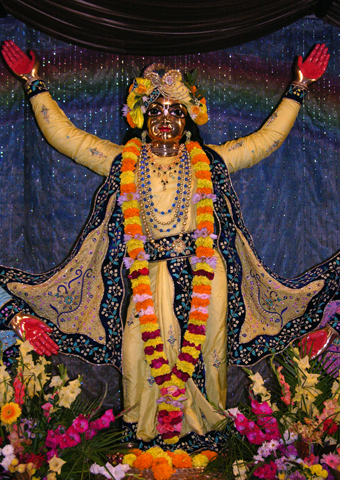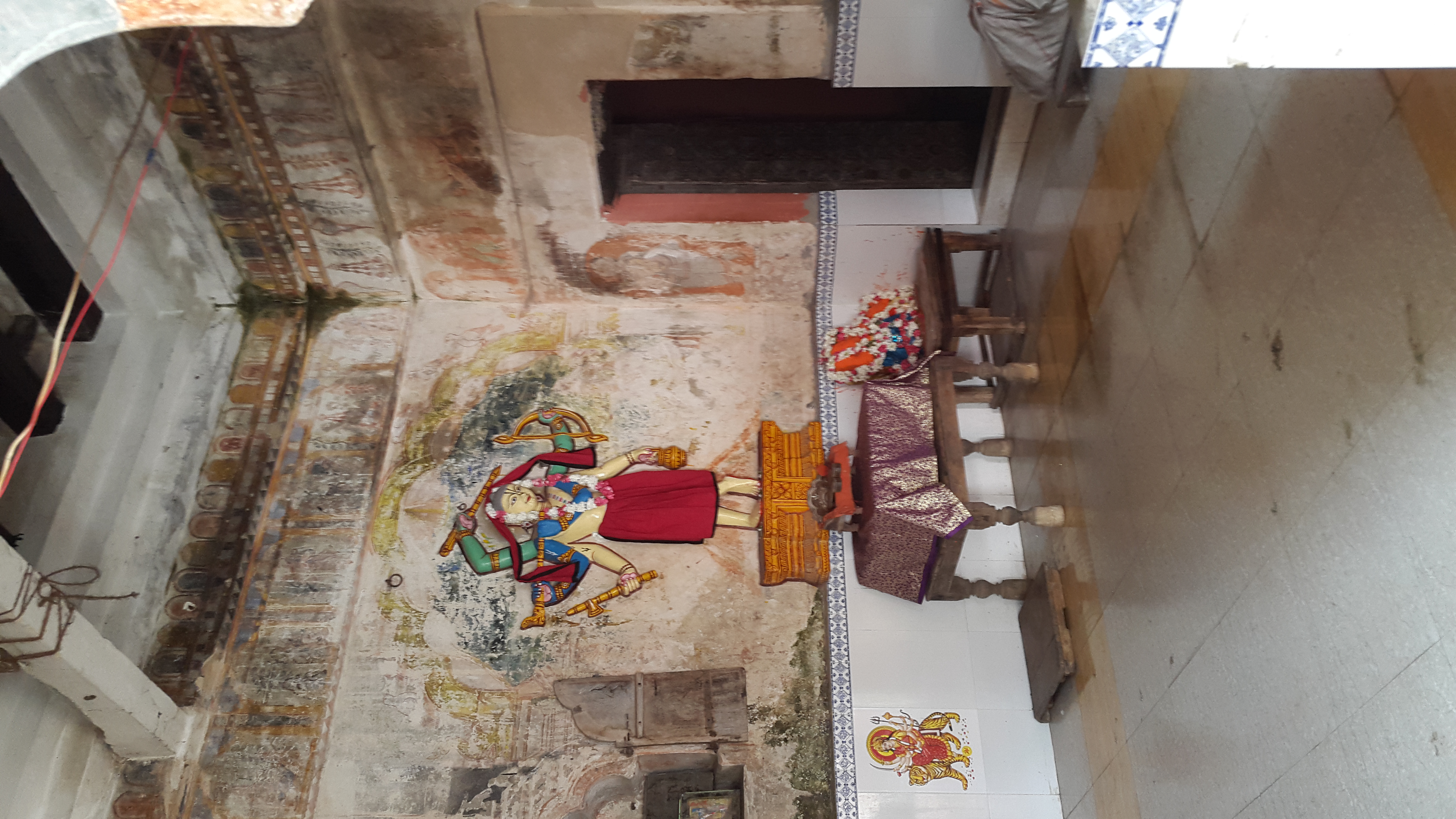|
Svarupa Damodara
Svarupa Damodara, / Swarup Damodar also known as Purushottama Acharya was a Gaudiya Vaishnava saint and close associate of Chaitanya Mahaprabhu. He lived in Navadvipa. He always stayed with Chaitanya. Purushottama Acharya did not accept the dress of a sannyasi, but only gave up the shikha and sacred thread. His name became Svarupa. After this, taking up the order of his sannyasa-guru, Purushottama Acharya went to Jagannatha Puri. At that time, he again met with Chaitanya. Swarup Damodar was the avatar of Lalita Sakhi of Vraj mandal dham. In the Nawadeep lila Lalita sakhi appeared as Swarup Damodar Goswami. Svarupa Damodara always stayed near the Lord. Whatever mood the Lord was in, Svarupa Damodara would perform kirtan to augment the Lord's internal sentiments. Around the same time that Svarupa Damodara came to Puri, Shri Ramananda Raya arrived from Vidyanagara. Shri Ramananda Raya was a great poet and could explain everything in a very elegant style. Shri Chaitanya Mahaprabhu ... [...More Info...] [...Related Items...] OR: [Wikipedia] [Google] [Baidu] |
Gaudiya Vaishnava
Gaudiya Vaishnavism (), also known as Chaitanya Vaishnavism, is a Vaishnava Hindu religious movement inspired by Chaitanya Mahaprabhu (1486–1534) in India. "Gaudiya" refers to the Gaura or Gauḍa region of Bengal, with Vaishnavism meaning "the worship of Vishnu". Specifically, it is part of Krishnaism— Krishna-centric Vaishnavite traditions. Its theological basis is primarily that of the '' Bhagavad Gita'' and '' Bhagavata Purana'' (known within the tradition as the ''Srimad Bhagavatam''), as interpreted by early followers of Chaitanya, such as Sanatana Goswami, Rupa Goswami, Jiva Goswami, Gopala Bhatta Goswami and others. The focus of Gaudiya Vaishnavism is the devotional worship (known as bhakti yoga) of Radha and Krishna, and their many divine incarnations as the supreme forms of God, '' Svayam Bhagavan''. Most popularly, this worship takes the form of singing Radha and Krishna's holy names, such as "Hare", "Krishna" and " Rama", most commonly in the form ... [...More Info...] [...Related Items...] OR: [Wikipedia] [Google] [Baidu] |
Chaitanya Mahaprabhu
Chaitanya Mahaprabhu (; born Vishvambhar Mishra) was a 15th-century Indian saint who is considered to be the combined avatar of Radha and Krishna by his disciples and various scriptures. Chaitanya Mahaprabhu's mode of worshipping Krishna with ecstatic song and dance had a profound effect on Vaishnavism in Bengal. He was also the chief proponent of the Vedantic philosophy of Achintya Bheda Abheda Tattva. Mahaprabhu founded Gaudiya Vaishnavism ( the Brahma-Madhva-Gaudiya Sampradaya). He expounded Bhakti yoga and popularized the chanting of the Hare Krishna Maha-mantra. He composed the '' Shikshashtakam'' (eight devotional prayers). Chaitanya is sometimes called Gauranga or Gaura due to his molten gold–like complexion. His birthday is celebrated as Gaura-purnima. He is also called Nimai due to him being born underneath a Neem tree. Life ''Chaitanya'' means "one who is conscious" (derived from Chetana, which means "Consciousness"); ''Maha'' means "Great" and '' ... [...More Info...] [...Related Items...] OR: [Wikipedia] [Google] [Baidu] |
Navadvipa
Nabadwip (), also spelt Navadwip, anciently Nadia or Nudiya, is a heritage city in Nadia district in the Indian state of West Bengal. It is regarded as a holy place by Hindus, and is the birthplace of Chaitanya Mahaprabhu. Famous for Rass festival where city is enlited with lights, dieties of God and goddesses are made on each corner of Nabadwip town. Hundreds of people gather to this small town on the occasion of raas utsab. Located on the western bank of the Hooghly River, it is considered to have been founded in 1063 CE, and served as the old capital of the Sena dynasty. A center of learning and philosophy in medieval India, the city is still noted for its traditional Sanskrit schools. The Navya Nyaya school of logic reached its peak with the efforts of some well known contemporary philosophers of Nabadwip. The great Vaishnava saint, social reformer and an important figure of the Bhakti movement, Chaitanya Mahaprabhu (1486–1534) was born here. It was after Chaitanya Mahapr ... [...More Info...] [...Related Items...] OR: [Wikipedia] [Google] [Baidu] |
Sannyasi
''Sannyasa'' (Sanskrit: संन्यास; IAST: ), sometimes spelled Sanyasa (सन्न्यास) or Sanyasi (for the person), is life of renunciation and the fourth stage within the Hindu system of four life stages known as '' Ashramas'', with the first three being Brahmacharya (bachelor student), Grihastha (householder) and Vanaprastha (forest dweller, retired). Sannyasa is traditionally conceptualized for men or women in late years of their life, but young brahmacharis have had the choice to skip the householder and retirement stages, renounce worldly and materialistic pursuits and dedicate their lives to spiritual pursuits. Sannyasa is a form of asceticism, is marked by renunciation of material desires and prejudices, represented by a state of disinterest and detachment from material life, and has the purpose of spending one's life in peaceful, spiritual pursuits. An individual in Sanyasa is known as a ''Sannyasi'' (male) or ''Sannyasini'' (female) in Hind ... [...More Info...] [...Related Items...] OR: [Wikipedia] [Google] [Baidu] |
Guru
Guru ( sa, गुरु, IAST: ''guru;'' Pali'': garu'') is a Sanskrit term for a "mentor, guide, expert, or master" of certain knowledge or field. In pan-Indian traditions, a guru is more than a teacher: traditionally, the guru is a reverential figure to the disciple (or '' shisya'' in Sanskrit, literally ''seeker f knowledge or truth'' or student, with the guru serving as a "counselor, who helps mold values, shares experiential knowledge as much as literal knowledge, an exemplar in life, an inspirational source and who helps in the spiritual evolution of a student". Whatever language it is written in, Judith Simmer-Brown explains that a tantric spiritual text is often codified in an obscure twilight language so that it cannot be understood by anyone without the verbal explanation of a qualified teacher, the guru. A guru is also one's spiritual guide, who helps one to discover the same potentialities that the ''guru'' has already realized. The oldest references to the concep ... [...More Info...] [...Related Items...] OR: [Wikipedia] [Google] [Baidu] |
Jagannatha Puri
The Jagannath Temple is an important Hindu temple dedicated to Jagannath, a form of Vishnu - one of the trinity of supreme divinity in Hinduism. Puri is in the state of Odisha, on the eastern coast of India. The present temple was rebuilt from the tenth century onwards, on the site of pre existing temples in the compound but not the main Jagannatha temple, and begun by Anantavarman Chodaganga, the first king of the Eastern Ganga dynasty. The Puri temple is famous for its annual Ratha Yatra, or chariot festival, in which the three principal deities are pulled on huge and elaborately decorated temple cars. Unlike the stone and metal icons found in most Hindu temples, the image of Jagannath (which gave its name to the English term 'juggernaut') is made of wood and is ceremoniously replaced every twelve or 19 years by an exact replica. It is one of the Char Dham pilgrimage sites. The temple is sacred to all Hindus, and especially in those of the Vaishnava traditions. Many g ... [...More Info...] [...Related Items...] OR: [Wikipedia] [Google] [Baidu] |
Godavari River
The Godavari ( IAST: ''Godāvarī'' �od̪aːʋəɾiː is India's second longest river after the Ganga river and drains into the third largest basin in India, covering about 10% of India's total geographical area. Its source is in Trimbakeshwar, Nashik, Maharashtra. It flows east for , draining the states of Maharashtra (48.6%), Telangana (18.8%), Andhra Pradesh (4.5%), Chhattisgarh (10.9%) and Odisha (5.7%). The river ultimately empties into the Bay of Bengal through an extensive network of tributaries. Measuring up to , it forms one of the largest river basins in the Indian subcontinent, with only the Ganga and Indus rivers having a larger drainage basin. In terms of length, catchment area and discharge, the Godavari is the largest in peninsular India, and had been dubbed as the Dakshina Ganga ( Ganges of the South). The river has been revered in Hindu scriptures for many millennia and continues to harbour and nourish a rich cultural heritage. In the past few decades ... [...More Info...] [...Related Items...] OR: [Wikipedia] [Google] [Baidu] |






